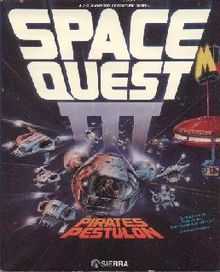Space Quest III
| Space Quest III: The Pirates of Pestulon | |
|---|---|
 DOS cover art | |
| Developer(s) | Sierra |
| Publisher(s) | Sierra |
| Designer(s) | Mark Crowe and Scott Murphy |
| Series | Space Quest |
| Engine | SCI0 |
| Platform(s) | DOS, Macintosh, Amiga, Atari ST |
| Release date(s) | March 24, 1989 |
| Genre(s) | Adventure |
| Mode(s) | Single-player |
| Distribution | 3.5" Floppy Disk or 5.25" Floppy Disk |
Space Quest III: The Pirates of Pestulon, the third game in Sierra Entertainment's Space Quest series, was released on March 24, 1989, and was developed using an early version of Sierra's SCI engine.
Plot
Roger Wilco's escape pod from the end of Space Quest II is floating in space until captured by an automated garbage freighter. Roger's first task is to repair an old ship found there, the Aluminum Mallard (a play on the Millennium Falcon and the Tin Goose) and leave the scow.
Roger visits a variety of locations, including a fast food restaurant called Monolith Burger and a desert planet called Phleebhut. At the latter, he encounters trouble, as Arnoid the Annihilator (an Arnold Schwarzenegger-like android terminator) hunts him for not paying for a whistle in Space Quest II (a continuity error in that the order form for the whistle clearly stated that it was in fact free). From information he picks up there and at Monolith Burger, Roger eventually discovers the sinister activities of a video game company known as ScumSoft, run by the "Pirates of Pestulon".
Pestulon, a small moon of the volcanic planet Ortega, is covered in soft, moss-like vegetation, and dotted with twisted tree-like growths throughout. Elmo Pug, the CEO of ScumSoft, has abducted the Two Guys from Andromeda and is forcing them to design awful games.
Roger manages to sneak into the supposedly impregnable ScumSoft building and rescue the two programmers. He is discovered, and must battle Elmo in a game that combines giant Mecha-style combat with Rock 'Em Sock 'Em Robots. After winning, Roger and the Two Guys escape, and in the game's conclusion, Roger delivers the two game designers to Sierra On-Line's president, Ken Williams, on Earth.
Technical details
Space Quest III featured music composed by Supertramp drummer Bob Siebenberg, and was one of the first games to support the new Sound Blaster sound card. PC versions of the game now supported mouse movement and a new, heavily improved text parser. Mouse movement was still in its primitive state at the time of the game, so Roger does not automatically find his way around obstacles in the game world (instead he just stops dead if he encounters a barrier). Computer mice were relatively new at the time, and Sierra's mouse movement would greatly improve in subsequent games.
Space Quest III also featured a minigame called Astro Chicken, which was not necessary to complete the game, but getting a high score revealed a hidden distress message that the Two Guys had programmed in.
Sound effects included digitized audio sampling, such as the voice of Roger Wilco speaking "Where am I?" during the introduction. The digitized effects can be heard in the Tandy, Amiga and Macintosh versions of the game. Though Space Quest III was designed to utilize the Sound Blaster's ability to play digital samples, the inclusion of an incorrect driver file left the effects unavailable to IBM PC users with the Sound Blaster card.
Unlike the two previous installments in the series, the player is not prompted to enter his or her name at the outset. In the previous games, the name would default to "Roger Wilco" as the official canon if no name was input.
Astro Chicken
Astro Chicken was the name of an arcade minigame in Space Quest III. Gameplay consisted of attempting to land a chicken on a trampoline. The mechanics of the game were similar to those of Lunar Lander, with the exception that the chicken would rebound unharmed if it struck the trampoline too forcefully. When the chicken landed safely, it would exclaim "Bacock!". The Astro Chicken theme music is a variation on Chicken Reel, a traditional folk song best known for its use in animated cartoons.
Sierra also released the Astro Chicken minigame as a demo to promote Space Quest III.
Reception
UK magazine C&VG gave the ST version a score of 83%, calling it "enjoyable and addictive".[1]
In 1989, Dragon gave the game 4 out of 5 stars.[2] The Macintosh & PC/MS-DOS versions of the game were also given 4 out of 5 stars.[3] Compute! praised the game's graphics and sound card audio, stating that they were the best of the series.[4]Computer Gaming World gave the game a positive review, noting improvements in the presentation and action sequences over its predecessors.[5] In 1989 the magazine gave it a Special Award for Achievement in Sound.[6]
In 2014, Space Quest III was featured in the debut episode of the retro gaming YouTube series Blast Backwards. Series director Aaron Steinke gives a fond recollection of the game calling it a "cult classic." [7]
References
- ↑ Campbell, Keith (September 1989). "Space Quest III". Computer and Video Games (94). p. 68.
- ↑ Lesser, Hartley; Lesser, Patricia; Lesser, Kirk (September 1989). "The Role of Computers". Dragon (149): 78–79.
- ↑ Lesser, Hartley; Lesser, Patricia; Lesser, Kirk (December 1991). "The Role of Computers". Dragon (176): 62.
- ↑ Guerra, Bob (November 1989). "Space Quest III: The Pirates of Pestulon". Compute!: 134. Retrieved 11 November 2013.
- ↑ Lombardi, Chris (August 1989). "Review: Space Quest III". Computer Gaming World. pp. 36–37.
- ↑ "Game of the Year Awards". Computer Gaming World: 8. October 1989.
- ↑ Steinke, Aaron. "Blast Backwards - Space Quest III (PC)". mediaglitch.net. Retrieved 5 November 2014.
External links
- Space Quest III at MobyGames
- Space Quest III can be played for free in the browser at the Internet Archive
| ||||||||||
| ||||||||||||||||||||||||||||||||||||||||||||||||||||||||||||||||||||||||||||||||||||||||||||||||||||||||||||||||||||||||||||||||||||||||||||||||